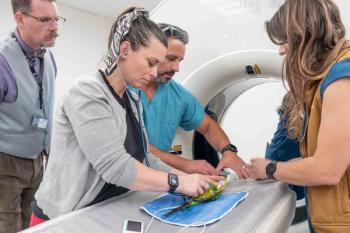
Bladder and reproductive ultrasonography: the good the bad and the really ugly (Proceedings)
Clipping the hair and applying alcohol and ultrasound gel is important for maximizing image quality. Ultrasound of the bladder should be performed with the bladder distended; therefore, the patient should not urinate prior to the exam. If the bladder is small and disease is suspected waiting until it fills or filling the bladder with isotonic saline is recommended.
General considerations
Clipping the hair and applying alcohol and ultrasound gel is important for maximizing image quality. Ultrasound of the bladder should be performed with the bladder distended; therefore, the patient should not urinate prior to the exam. If the bladder is small and disease is suspected waiting until it fills or filling the bladder with isotonic saline is recommended. The bladder in dogs and cats is easily identified in the caudal abdomen with the animal in dorsal recumbency (lateral recumbency can also be used). The standing position can also be used to try to determine whether a structure in the bladder is gravity dependent. Occasionally a small, intrapelvic bladder can be difficult to locate. A transducer with a small footprint may be necessary for intrapelvic imaging, while a linear or curvilinear can be used for most animals. Generally a 5-10 MHz transducer is adequate for most dogs. Higher frequency may be used for cats and small dogs for the best image resolution. Scanning the bladder completely in the longitudinal and transverse plane is important so lesions are not missed.
Ultrasound of the normal bladder
The size of the bladder is highly variable. The bladder wall thickness will be highly variable depending on degree of distention. In dogs the thickness of the bladder wall increases with body weight. In a cat the wall thickness is around 1.5 mm. The ureters are not seen unless abnormal, but occasionally the ureteral papilla is seen as a focal thickening of the wall in the trigone region. At the trigone occasionally ureteral jets can be seen as an intermittent burst of hyperechoic speckles. This only occurs if there is a difference between the specific gravity of the urine within the bladder and the ureter. Urine is anechoic, but may have variable amounts of echoes even in the normal animal. The proximal urethra may be visible dependent on the positioning within the pelvic canal. In the male dog the penile urethra can be seen via a perineal and preputial window.
Ultrasound of bladder abnormalities
Calculi are variable in size and shape, but should be hyperechoic with distal acoustic shadowing. Calculi are gravity dependent; therefore, should move around with positioning of the animal (which is sometimes helpful in distinguishing calculi from wall mineralization). Urethral calculi can be seen depending on their location (if US is accessible to the area). Dilation of the urethra is consistent with obstruction (calculi, neoplasia, stricture, inflammation, etc.).
Crystals can be seen as hyperechoic echoes within the lumen that swirl when the bladder is agitated and often settle to the gravity dependent portion.
Transitional cell carcinoma is the most common bladder and urethral neoplasia. Neoplasia results in a thickening of the wall, most commonly in the trigone region, but it can occur anywhere. Neoplasia generally has a broad-based attachment to the wall with a very irregular mucosal margin. Echogenicity of a mass is highly variable. Mineralization, hyperechoic with distal acoustic shadowing, can occur within the mass. Color Doppler will show blood flow within the mass. If the mass is at the ureteral papilla then obstruction resulting in hydroureter and hydronephrosis can be seen. Masses can also extend into the urethra. The medial iliac lymph nodes should always be evaluated to look for extension of disease. Abdominal radiographs are also indicated to assess for changes in the caudal lumbar vertebrae.
Cystitis causes irregular thickening of the bladder wall that is commonly most severe at the cranioventral aspect. Polypoid cystitis, which is much less common, is seen as hyperechoic, pedunculated masses that project into the lumen.
Emphysematous cystitis is defined as gas within the bladder wall. The gas will be variable amounts of hyperechoic interfaces with distal reverberation. When trying to decide if gas is within the bladder wall or free within the lumen repositioning the animal is helpful. Luminal gas should redistribute to the non-dependent portion of the bladder when repositioned.
Intraluminal blood clots are sometimes seen and are most often hyperechoic, mobile structures. If adhered to the bladder wall these can sometimes be mistaken for neoplasia. Color Doppler can help in the evaluation, as blood clots will not have blood flow. Mural bleeding can also cause thickening of the wall.
Congenital anomalies such as ectopic ureters, urachal diverticuli, and ureteroceles are sometimes seen. Ectopic ureters are most easily visualized if they are dilated and can be followed beyond the trigone region. Ureteroceles are cystic dilations of the ureter within the bladder. Urachal diverticuli result in a triangular, convex, out-pouching of the bladder at the apex.
Tears in the bladder wall secondary to trauma are difficult to visualize with ultrasound. Most commonly a diagnosis of rupture is made either by sampling abdominal effusion or by positive contrast cystography.
The colon can sometimes indent the dorsal bladder wall and be mistaken for a calculus. Changing the transducer orientation from the transverse to the longitudinal scan plane should clarify this artifact.
Ultrasound of the normal prostate and testicles
The prostate gland is visualized by following the bladder caudally. Depending on the degree of enlargement of both the bladder and the prostate it may or may not be within the pelvic canal. Occasionally I will have someone manually push the prostate forward via rectal palpation. In normal intact dogs the prostate is hyperechoic and homogenous with a round to oval shape (on sagittal scan) and smooth margin. In the transverse scan plane the bi-lobed nature of the prostate can be seen. The prostatic urethra and urethralis muscle can be recognized as a hypoechoic region between lobes. Increasing size of the prostate is expected as intact dogs age. In neutered dogs the prostate is small (usually less than 1 cm diameter) and hypoechoic.
Evaluation of the testicles is best performed with a high frequency linear transducer. The normal testes are of medium echogenicity and are homogenous except for the mediastinum testis, which is a thin hyperechoic linear structure located centrally. The margins are smooth and the size is dependent on weight. The epididymis is located dorsal to the testicles with the head at the cranial pole and tail at the caudal pole. Relative to the testicle the epididymis is hypoechoic with a coarse echotexture.
Ultrasound abnormalities of the prostate and testicles
Benign prostatic hyperplasia (BPH) in intact male dogs is common and is considered an incidental expected finding. The prostate will be large and hyperechoic (may be homogenous or inhomogenous). The two lobes are generally symmetrical, although some asymmetry may be seen. Small cysts are sometimes seen with benign prostatic hyperplasia.
Prostatitis can result in a normal size to enlarged prostate. The echogenicity and echotexture are highly variable and overlap with BPH and neoplasia. Acute inflammation can result in small amounts of fluid surrounding the prostate as well as increase in echogenicity of the paraprostatic fat. Dystrophic mineralization is occasionally seen with chronic prostatitis.
Larger prostatic cysts characterized as thin-walled structures with anechoic fluid and through transmission may be seen. If the fluid is more echogenic then abscess should also be considered. There is overlap in the ultrasound appearance of cysts and abscesses.
Paraprostatic cysts are located adjacent to the prostate rather than being contained within the parenchyma. They may communicate with intraprostatic cavitations. The fluid can be variable in echogenicity from anechoic to echogenic. If large enough the paraprostatic cysts can sometimes be mistaken for urinary bladder. If the location of the urinary bladder is difficult infusion of saline or withdrawal of urine can be performed for localization.
Prostatic neoplasia can be variable in echogenicity. The prostate is usually enlarged, inhomogenous, and often irregular. Mineralization and metastasis to medial iliac lymph nodes is common. Masses can extend into the urethra and bladder.
Abnormal testicular findings with ultrasound include neoplasia, inflammation, cysts, torsion, cryptorchidism, atrophy and trauma. Neoplasia, such as interstitial and Leydig cell tumors (both of which are considered benign), and seminomas or Sertoli cell tumors (both considered malignant) cannot be differentiated with ultrasound. Hormone producing tumors tend to have concurrent prostatomegaly and medial iliac lymphadenopathy may be seen. Tumors can range in size, echogenicity and echotexture. Inflammation can cause diffuse changes (usually decreased echogenicity) of the testicle or epididymis or result in focal abscesses. Fluid within the scrotum can sometimes be seen. Cysts, characterized by thin-walled, anechoic areas with distal acoustic enhancement are generally incidental findings. Torsions can have a variable appearance based on duration. The testicles can be hyper or hypoechoic, small or large, and concurrent fluid in the scrotum is common in acute cases. Color Doppler is helpful to evaluate for lack of blood flow. Cryptorchid testicles can be difficult to find, but searching from the caudal pole of the kidney through the inguinal region is recommended. If the testicle becomes enlarged due to disease it's location within the abdomen can be somewhat variable. Measurements correlating with size of dog have been reported. These measurements are useful when determining atrophy. In addition to evaluation of size atrophied testicles are hypoechoic. Scrotal hemorrhage secondary to trauma will be variable in echogenicity dependent on the time of imaging post-trauma.
Ultrasound of the normal uterus and ovaries
The uterus in a normal dog or cat is difficult to see. Localization of the uterus between the dorsal bladder wall and colon is sometimes possible. If identified the uterus may be followed cranially to the bifurcation into the uterine horns. The uterine horns are also difficult to follow as they will blend with and be hidden by the intestinal tract. Normal pregnancy will not be covered in this lecture. The postpartum uterus contains fluid and has increased wall thickness, both of which decrease over 3-4 weeks. Findings must be associated with clinical signs as there can be overlap in imaging findings with normal involution and pyometra.
Normal ovaries can be located caudolateral to the kidneys. They are oval in shape and measure around 1 cm in length in the cat and 2 cm in length in the dog. The echogenicity of the ovaries is dependent on the stage of the estrus cycle.
Ultrasound of uterine and ovarian abnormalities
Ovarian cysts and large follicles are thin-walled, smooth, anechoic structures with distal acoustic enhancement. Because the type of cyst or follicle cannot be distinguished with ultrasound, these findings need to be associated with the clinical signs.
Ovarian neoplasia will appear as nodules or masses of varying shape, size, and echogenicity. They can also have cystic areas or mineralization. Tumor type cannot be distinguished without cytology/histopathology. Common concurrent findings include cystic endometrial hyperplasia, pyometra, and ascites.
Uterine abnormalities covered include pyometra, mucometra, hydrometra, cystic endometrial hyperplasia, and neoplasia. Hydrometra tends to have anechoic fluid within the lumen, while mucometra and pyometra fluid tends to be more echogenic. There is enough overlap between these entities that they cannot be definitively determined with ultrasound. Cystic endometrial hyperplasia appears as thickening of the wall with small cysts within the endometrium and small amounts of fluid within the lumen. Neoplasia (most commonly leiomyomas, leimyosarcomas, and adenocarcinomas) is variable in size, shape, and echogenicity.
Uterine stump disease (pyometra, granuloma, neoplasia) can occur as mass lesions between the bladder and colon.
Interventional techniques
Ultrasound guided cystocentesis is very common and easy to perform. For cystocentesis a 22-gauge, 1 to 1 ½ inch needle is used. If the bladder is relatively small it is often necessary to "pop" through the wall by using a jab technique.
Ultrasound guided aspirates and biopsy of bladder masses are generally not performed due to potential spread of disease at the needle tract.
Aspirates of the prostate and ovarian masses can be performed. Aspirates of testicular masses can be done; however, castration is generally performed instead.
Newsletter
From exam room tips to practice management insights, get trusted veterinary news delivered straight to your inbox—subscribe to dvm360.






